 Fleet Aircraft Carrier (R09), 1943-1979
Fleet Aircraft Carrier (R09), 1943-1979British Cold War Carriers:
Majestic class | Centaur class | HMS Victorious | HMS Eagle | HMS Ark Royal | HMS Hermes | CVA-01 project | Invincible class | HMS Argus | Queen Elisabeth class (planned)This was the last great, true fleet British aircraft carrier, and perhaps the best of them all before it was decided to retire her. The smaller HMS Hermes had a longer career, sure, but she was the only British carrier large enough to operate the capable, multirole F4 Phantom II. The second of the large audacious class, she was modified so thoroughly as ending as her own class for most authors. She became the last remaining conventional British catapult and arrested-landing aircraft carrier, but also she was the first to be equipped with an angled flight deck at commissioning in 1955, while her near sister HMS Eagle was the RN’s first angle-decked aircraft carrier after 1954 modification. HMS Ark Royal, last of the name so far, was decommissioned and stricken in 1979.

Development
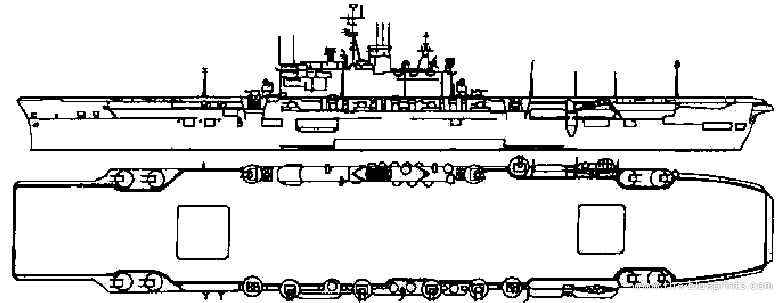
A lot had been already said and written on the Audacious class carriers, largest (outside the never built Malta class). Albeit renamed, she was part of a class of four 32,500t improved Implacable class fleet carriers, with the same armoured hangar concept. HMS Audacious was the most advanced at the end of the war but she was renamed HMS Eagle in January 1946 after its following namesake was cancelled. Ark Royal, was held up to add numerous improvements and they ended both with very differed designs. In 1946 their designed was revised and went up to 36,970t standard and 45,720t deeply loaded.
The Audacious class was a WW2 desigh originally comprising HMS Audacious, Eagle, Irresistible and Africa. They were the product of war lessons in 1941 with improved flight deck armour, better designed armoured box, increased aircraft capacity and flight deck size. Drawings were submitted by November 1941 for 27,000 ton ships with a larger forward lift and reviewed hangars for 54 aicrafts and the depth of structural beams reduced. By early 1942 the work focused on hangar space and achieving a better deck paking to reach 80 aircraft (60 on Implacable, 45 on Illustrious). By Late 1942 it became the Irresistible class, and the design was revised again to manage 30,000lbs aircraft, and later 17ft 6in (USN standard) hangar in height, 500ft take off distance, revised arrester gear, until it was cancelled on November 30, 1941, and reformulated as the Audacious class.

HMS Eagle and Ark Royal together, the only Audacious class carriers ever built.
They had notably double storied hangars, and the design was considerably enlarged in 1942 for stability. The initial flight deck was 795 feet by 102 feet 6 inches (242.3 x 31.2m or 7,560m²) and there were two BH-V catapults installed, two rectangular 54 x 44 feet lifts for 30,000 Ibs models connected to the two 17 feet 6 in (5.3) high hangars inside the armoured “box” for a combined 52,100 square feet (4,840 m2), 25,652m³. Petrol stowage was 103,300 gallons (465,000 liters avgas).
Protection was improved with 4-inches (102 mm) backed by 1 inch structural steel on deck, 2-inches and a half for the upper hangar floor, 1-2 inches for horizontal protection, 4 inches for the magazines, and better underwater protection. They ended 244 meters long, with a tactical diameter was about 720 yards initially sixty 20 mm Oerlikon guns to protect them, and then 64x 40 mm Bofors in sextuple mounts and still 18 Oerlikon 20 mm.
HMS Audacious was laid down at Harland and Wolff on 24 October, 1942, renamed 1946 as Eagle (R05), completed by October, 1951. “HMS Irresistible”* (later R09) was laid down at Cammell Laird, Birkenhead on 3 May, 1943 and renamed as HMS Ark Royal in 1945, launched 3 May, 1950, completed 22 February, 1955, first with an angled deck. The next HMS Eagle ordered from Swan Hunter by August 1942 and transferred to Vickers-Armstrong in December was laid down only by 19 April, 1944 and Cancelled in January 1946. HMS Africa was ordered from Fairfield on 12 July 1943 but became a Malta-class aircraft carrier in 1944, cancelled on 15 October, 1945.
*According to many authors and conway’s, the name is completely bogus and never was official. She was first and only named Ark Royal.
Design of the class
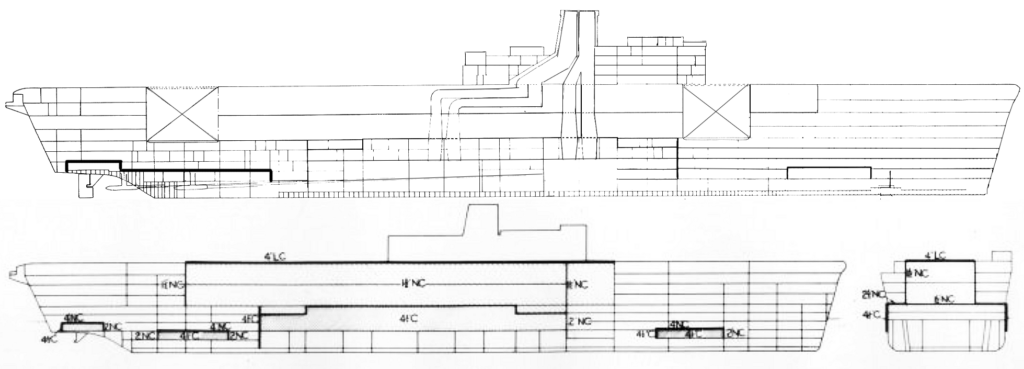
Internals of the class
Now we have the basis, let’s dive into the specific of Ark Royal revised design. If Cammell Laird (River Mersey) was contracted on 19 March 1942 to build her initially as HMS Irresistible, this was changed to Ark Royal to commemorate the original interwar Ark Royal, lost in 1941. She turned out to be the largest warship ever built at Cammell Laird and she was laid down on its Birkenhead shipyard on 3 May 1943 under yard number 1119. Construction proceeded very slowly as other priorities diverted resources and workforces, notably to win the battle of the Atlantic and completing cruisers and battleships. It was suspended after the end of WW2, not because of orkforce issue but to keave designers time to catch up on the latest war lessons and upgrade the design. Ark Royal was thus launched by Queen Elizabeth (wife of King George VI) in a grand ceremony on 3 May 1950. She was completed on 25 February 1955 and eventually commissioned at Devonport in 1956.
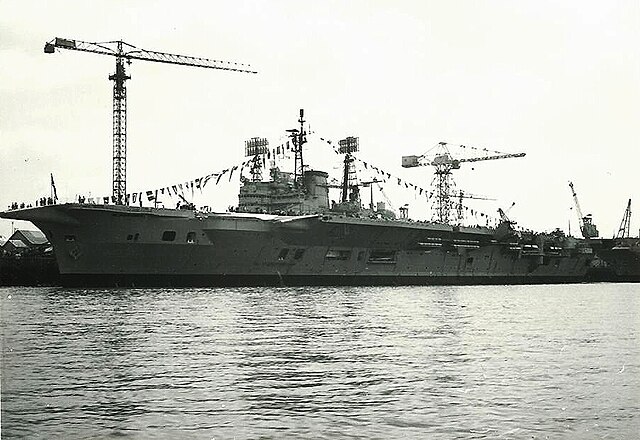
Ark Royal fitting out at Cammell Laird
The redesign made her quite different from HMS Hermes. While in construction at Cammell Laird she was painted with her white undercoat in construction by photographer E. Chambré Hardman, exhibited in British tours as “Where Great Ships Are Built”, later “Birth of the Ark Royal”. When commissioned her sticking feature was a 5.5° partially angled flight deck, a brand new feature, whereas Eagle still had a straight deck. She also had the same two revised steam catapults capable of launching 30,000 pounds (14 tons) fully loaded aircraft and an deck-edge lift, port side also a complete innovation, as well as a modified armament plus a new mirror landing system. Both catapults and angled deck enabled simultaneous landings and take offs, with fully loaded aicrafts loaded from the first hangar via the forward lift just in front of one of the two catapults. Meanwnhile recovery took place aft. There was also a large deck (800 by 112 feet/244 by 34 metres) parking space, enough to showcase 24 Sea Hawk, 6 Farey Gannet, 8 Sea vixen and one helicopter all parked for a parade in the early 1960s.
take off from the carrier at the same time.
Hull and general design
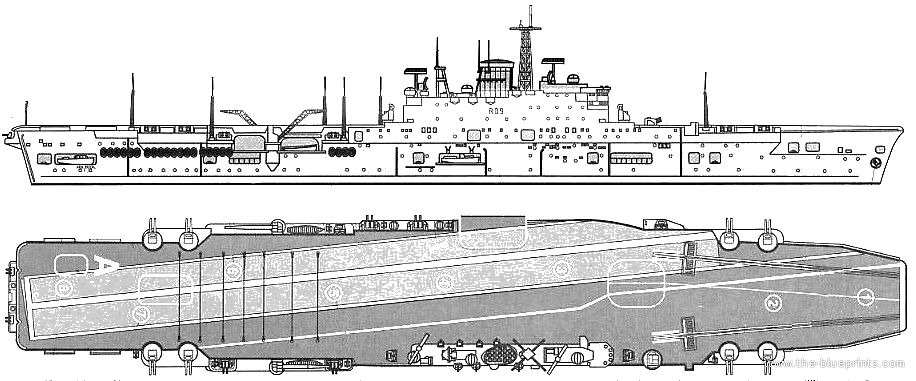
Final design as completed in 1956. Note the “angle deck” is quite limited.
As completed in 1956, Ark Royal’s hull measured 804 feet (245 m) overall, for a beam of 112 feet (34 m) as built, waterline, and modified after her 1978 refit to 171 feet (52 m) overall at deck level. Draught was 33 feet (10 m) standard and 31 feet (9.5 m) deep. Initially she had a displacement of 36,800 long tons (41,200 short tons; 37,400 t) as built and 43,060 long tons (48,230 short tons; 43,750 t) fully loaded, and then 53,950 long tons (60,420 short tons; 54,820 t) fully loaded after her 1978 refit.
Powerplant
It was unchanged and the same as Eagle: Four 3-bladed bronze propellers connected to shafts driver by four sets of Parsons geared turbines, fed in turn by eight Admiralty 3-drum boilers, located in four boiler rooms for a total output of 152,000 shaft horsepower (113,000 kW) giving her a top speed of 31.5 knots (58.3 km/h). Range was 7,000 nautical miles (13,000 km) at 14 knots (26 km/h) down to 5,000 nautical miles (9,300 km) at 24 knots (44 km/h). Nothing beats up good old steam machinery at that point for large ships.
Armament
As built she was planned to receive sixteen 4.5 inch (113 mm) guns in eight 8 twin turrets, and fifty-two 40 mm Bofors in the following arrangement, six sextuple, two twin and tweve single.
For her 1969 refit she was planned to received four Seacat missiles but they were never fitted. She however received four Corvus Decoy launchers.
5-in (120mm)/45 Mk 6 DP guns

Essentially the same turreted mounts, four corners of the hull, flight deck eight for cross-firing like Illustrious/Indefatigable.
RP 10 Mk II** twin-gun turrets in sponsons, flat roofs, flush with deck. Muzzle velocity 2,449 ft/s (746 m/s), 12 rpm, to 20,760 yards (18,980 m) and +45° 41,000 feet (12,000 m).
The Mark V guns used remote power control (RPC) to auto train/elevate, slaved to director. High rate-of-fire by automatic ramming. Separate high-angle/low-angle hoists for AA or SAP/HE for 24 rpm power-loaded, 12–14 hand-loaded back up, 18 burst mode hand-loaded, 800 rounds total. See modifications.
40mm/60 Mk 6 Sextuple mounts

Mark VI six-barreled mounts fed by large trays and with remote control, enslaved to their dedicated radar-equipped director. Also installed on HMS Vanguard and HMS Eagle. The Bofors mounts could elevate to +90°, fire a 1.97-pound (0.89 kg) shell at 2,890 ft/s (880 m/s) to 10,750 yards (9,830 m). 120 rpm, c900 rounds per gun. Sonsoned on either side close together amidships, six on starboard, two port. Remaining twins and single mounts located where possible, starboard and in the “inner perimeter” of the flight deck. Removed from 1955 onwards.
Protection
Like Eagle it was upgraded and ended this way:
(Flight deck: 4-in (102 mm)+ 1 in structural steel. (102mm+25mm, 37mm outside citadel)
-Lower hangar deck: 2-in and a half vertical, 1 in and a half horizontal (64-25mm, sides 38mm protection).
-Magazines/steering gear: 4 in horizontal protection (114 down to 51mm vertical, 102mm horizontal armour)
-Underwater protection: Longitudinal bulkhead 63mm, sandwich oil fuel/seawater (vs.1200 ib charge up to 2000 ib).
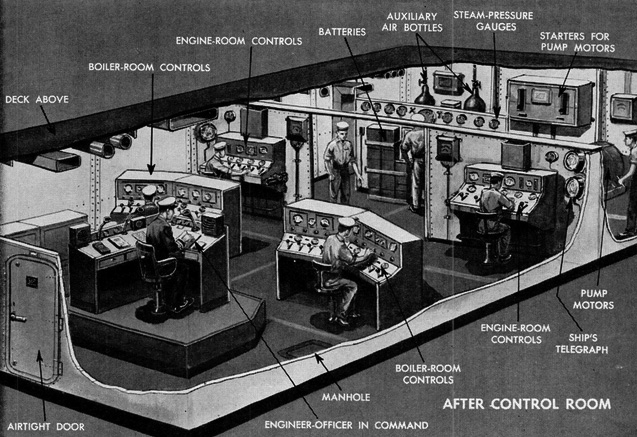
Aft Control Room (pop sci)
Sensors
As built
Type 960: VHF-band long-range warning radar. 86-90 MHz, 0-7 rpm, PRF 250 Hz pwd 5-15 µs, bwd 35° PP 450 kW RA 175 NM (324 km)
Type 982: Air direction radar, audacious and Centaur class
Type 983: 3 GHz S band height finding radar, PTF 500 Hz pwd 0.7-1.9 µs, bwd β5° ε2.1°, PP 500 kW, RA 130 km 7 min⁻¹ rpm
Type 275: Four F-Band fire control radars for the main 4.5 in DP turrets
Type 262: X Band, Ten Fore control radars the Bofors mounts
Type 974: X-band surface search radar used for pilotage and navigation.
After 1970 refit
-Type 974 Navigation Radar: 9 405 MHz (X-band), PRF 1000 Hz pdt(τ) 0.14 or 0.26 µs PP 7 kW RA 25 NM (≙ 46 km) acc 2% bwt 1.6° rpm 24 min⁻¹. More
-Type 993 Medium range radar (E/F band): Air and surface search, target designation. “quarter cheese” shape. More
-Type 986: It was in sync with 965, no more data.
-Type 963: Carrier Controlled Approach Radar.
-2x Type 965: Long Range Air Search Radar. More
-2x Type 987: Fwd and aft height finding radars.
Air Group

Ark Royal full Air group for a parade, seen in the late fifties, showing her appearance as completed by Cammell Laird in 1955.
As initially planned in 1944 she was to have 78 aircraft in hangar capacity alone, 90 overall with a deck park. She was to fly the Supermarine Seafire, Fairey Firefly, De Havilland Sea Hornet, Hawker Sea Fury, Fairey Barracuda, and Blackburn Firebrand. But once she entered service in 1956, it was deeply modified.
Her new air group comprised 50 aircraft, Hawker Sea Hawk (jet), Westland Wyvern (turoprop), and De Havilland Sea Venom fighters (jet) as fighters.
For assault and ASW she was to carry the latest Fairey Firefly, the Grumman Avenger, later replaced by the Fairey Gannet.
For electronic warfare she operated the Skyraider EEW planes
For SAR, plane guard, laisons she operated the Westland Dragonfly and Bristol Sycamore helicopters.
In 1960 she operated 14 Supermarine Scimitar F.1, and six De Havilland Sea Vixen FAW.1 as well as four Fairey Gannet AEW.3 and no les than fourteen Wesltland Whirlwind HAS.7 for assault and a single Westland Dragonfly HR.5 for SAR.
In 1977 at the end of her carrer, she operated 14 Phantom FG.1, 12 Blackburn Buccaneer S.2 (capable of carrying an atomic bomb), five Gannet AEW.3 and seven Sea King HAS.1, plus a Westland Wessex HU.5.

McDonnell F4K FG Mk.1 Phantom II 892 NAS, XT871, HMS Ark Royal March 1969

Blackburn buccaneer S.2C 809 NAS, HMS Ark Royal Jan 1972
Fairey Gannet (to come)

HMS Ark Royal in 1977, Conway’s profile and overview.
⚙ specifications |
|
| Displacement | 36,800 t standard, 46,000t FL |
| Dimensions | 804 x 112 x 33 feet (219.5 pp/245.0 oa x 34.4 wl/31.2 fd x 9.50 deep load) |
| Propulsion | 4x sets Parsons geared steam turbines, 8 Admiralty 3-drum boilers, 152,000 hp |
| Speed | 32 kts |
| Range | 7,490t oil, 5000 nm/24 kts |
| Armament | 8×2 × 4.5 inch (113 mm), 52 × 40 mm Bofors, see notes |
| Protection | Belt: 4.5-in(114mm) hangar 2-in (38mm), bulkheads 4.5-2 in, flight deck 4-in(102 mm) |
| Sensors | Type 960, 982, 983, 275, 262, 974, see notes |
| Air Group | 78 aicraft initially, see notes |
| Crew | 2740 |
Modernizations

As modernized, in heavy weather.
Four years passed before HMS Ark Royal even commenced her sea trials. Modifications started right away:
-In 1956 she had two twin 120mm/45 removed, as well as her type 275 radar. Removal of the port 4.5 inches (110 mm) guns were to improve aircraft operations over the angled deck.
-By September 1959, her deck edge lift was removed as well as two sextuple 40mm/60, and six single 40mm/60 bofors and two type 262 radars replaced by the type 965M radar.
-In 1961 she received new more powerful catapults.
-1964 refit: Two 4.5 inch gun mount remaining, aft port and starboard.
-From 1967 to February 1970: Major rebuild but more austere update of electronics, to operate the Phantom.
Her later upgrades were marred by costs concerned combined with the age of the hull as well as changing if optinions in the political sphere over naval requirements, with some talking of her being scrapped. The Navy each time managed to place convincing arguments to retain and upgrade her.
The last planned refit was to cost £30 million, far less than for Eagle, in order to comfortably operate the Phantom and Buccaneer Mk.2.
-Full 8.5° angled flight deck
-Far more powerful steam catapults
-New stringer bridle-catchers
-Heavy-grade jet-blast deflectors
-Heavy-weight arrestor cables.
-12,000 miles of new cabling installed (but she retained her old DC electrics).
-Modified island, different arrangement from Eagle
-Partially new electronic suite, Type 983 retained, no 3-D air-search radar, but double-array 966, standard RN 965 long-range.
-AN/SPN-35 approach radar (only one to do so) for night capability and safety.
-Flight deck size increased port aft for extra deck-park space.
-Four Seacat missile launchers (planned but never installed)
-Four Corvus decoy launchers.
-Limited overhaul of her steam turbines and boilers and use for spared from HMS Eagle.
Ark Royal was scheduled for five years more service but the new government decided otherwide by 1975 due to new maintenance and service programme related to task groups so she ws extended up to 1978, until the number of mechanical and electrical failures led to decommissioning in early 1979.
Conway’s take on Ark Royal
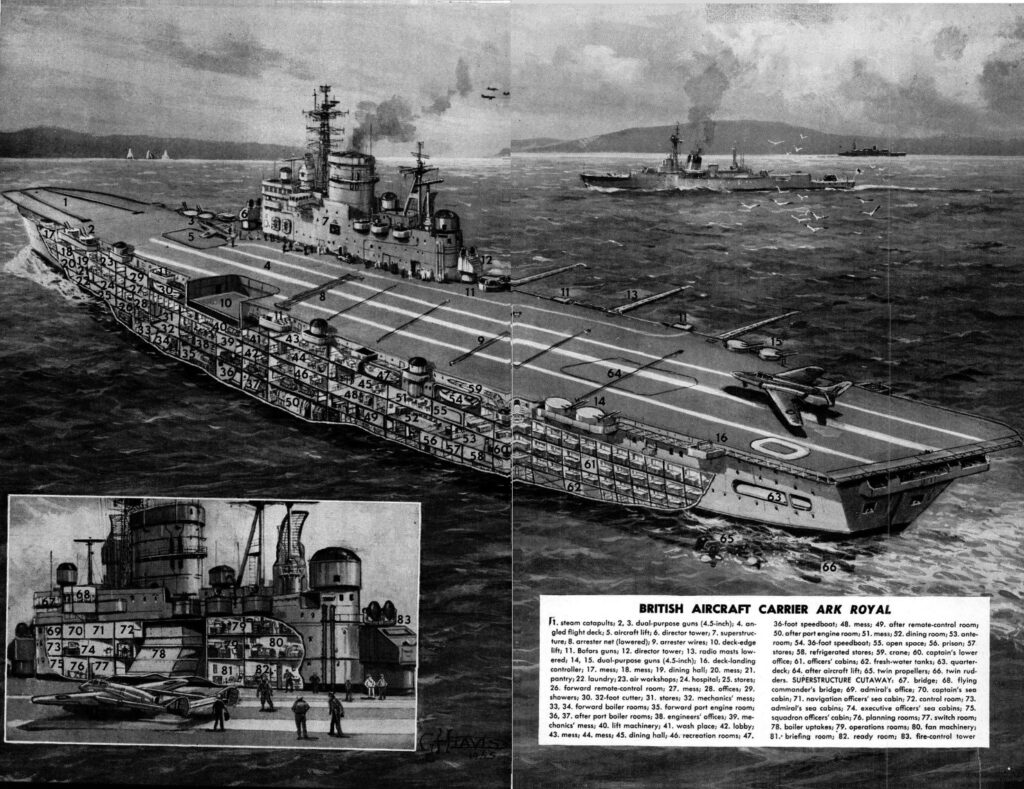
Although often claimed to have been projected as HMS Irresistible, there is no Official record of this name. The ship was in fact laid down 18 months after the previous Ark Royal was sunk, and there was every reason to reserve that name for a new carrier, She was not very far advanced at the end of the war and so the opportunity was taken to change the design considerably, but this made her completion more and mere protracted, until she became the butt of comedians’ jokes. She finally started trials in June 1954 and entered service in February 1955.
The most important alteration was to provide her with a deck-edge lift, as in US carmers. It was never a great success because it served the upper hangar only, and in any case the device was not really suited to the British type of closed hangar. The port forward 4.5in guns were never installed because the ship went to sea with a 5° angled deck, and this also meant a smaller number of 40mm guns on the port side, as in Eagle. She had a tall lattice foremast, and a different island.
As with Eagle it proved difficult to accommodate two 210ft steam catapults on the foredeck, and so when these were installed in 1967-70 an unusual deposition was adopted, with one on the port side forward and the other in the waist.
Ark Royal underwent many more changes than Eagle. In 1956 the starboard 4.5in turrets were also removed, followed by the forward pairs (port and starboard) of the after group in 1964 and the rest in 1969. During the 1959 refit the side lift was removed to allow the hangar to be enlarged, and in 1961 a deck-landing projector sight was installed, with the ‘Hilo’ long-range guidance system and stronger steam catapults. Between March 1967 and February 1970 she underwent a major refit to allow the operation of Phantom F-4K interceptors and Buccaneer $2 strike aircraft. This involved removing the last of the 40mm guns; it was planned to replace them with four Seacat missile systems, but these were never installed.

At Hampton roads, 1957
The radar outfit always differed from Eagle’s. As built, Ark Royal had two Type 982 ‘hayrake’ scanners and two Type 983 height-finders, with Type 262 fitted to the directors controlling the 40mm guns, and Type 275 controlling the 4.5in. In 1959 a double bedstead’ Type 965M aerial was stepped on a short lattice mast forward of the mainmast; in 1967-70 a second 965M was added on a much taller lattice mainmast, and a large dome abaft the island, housing a Car| rier Controlled Approach (CCA) radar of US origin, was fitted. Although completed later than Eagle, the ‘Ark’ was never as mechanically reliable, and had the 1966 Defence Review not cancelled her replacement (CVA-02) she would have been scrapped first.
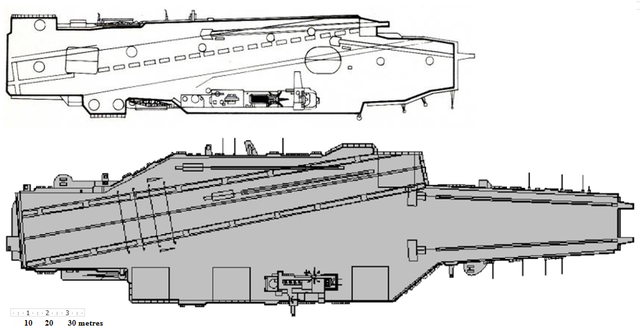
Compared with USS Independance
In 1966 it was felt that she might last until 1972 without major repairs to her machinery, and the fact that she staggered on for another six years is testimony to the heroic efforts of her engineers. Although hard-worked she missed all the important actions except the Indonesian Confrontation, and had tt not been for a thirteen-week TV serial called ‘Sailor’ she might never have endeared herself to the public in the way that she did. Despite efforts to raise money to preserve her the MoD steadfastly refused to sanction any unworthy scheme; in any case the sums talked of were wildly unrealistic, and she was towed away in the autumn of 1980, After she had been paid off at Devonport in December 1978 her name was given to the third af the Invincible class.
Ark Royal in service
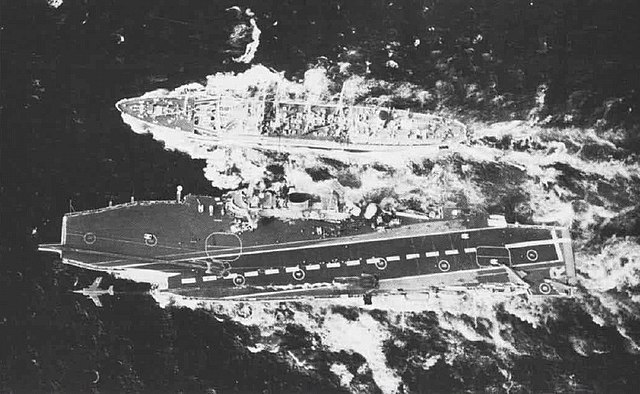
Top view early in her career, in RAS
HMS Ark Royal took part in many exercises with the fleet and NATO, as the center of a task force and to provide squadrons cover during her active life. But she never saw any combat duty. Not only she was ordered however for the Suez Crisis of 1956, but this was postponed after she ran a main propeller shaft bearing while underway to Egypt. She entered the drydock at Devonport for a major refit, replaced by HMS Eagle at Suez. In 1963, she was the first trialling the new Vertical/Short Take Off and Landing (V/STOL) Hawker P.1127 prototype, later developed as the Hawker Siddeley Harrier, transformative for the RN. It was indeed accepted for the new 1980s carriers that will doomed her.
She took part in the Beira Patrol, the naval blockade of Rhodesian in 1965.
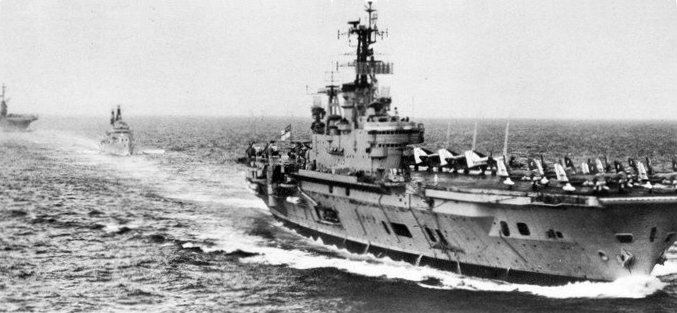
Underway in 1962
In 1966 a Defence White Paper planned already preconised to end British aircraft carriers by the early 1970s already due to maintenanec and crew costs concerns. Ark Royal went into dock for her refit nevertheless through political debate, during which the new government re-examined theur case and estimated new shore-based aircraft were good enough to cover British needs, “East of Suez”.
On 9 November 1970, she took part in a Mediterranean NATO exercise.
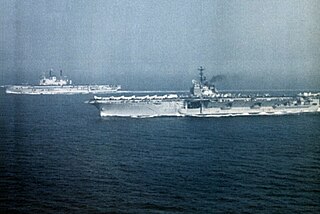 She collided with the Soviet Kotlin class destroyer Bravyy, shadowing her a bit too far. The carrier was slightly damaged, as the destroyer, but she missed two of her crew. Ark Royal’s Captain Raymond Lygo was cleared of blame after court martial was held due to the “unprofessional behaviour” of the Soviet destroyer’s commanding officer. She took part also in the 1960s British TV series “Not Only… But Also” starring Peter Cook and Dudley Moore, firing off by catapult into the sea such items as pianos and a full toilet.
She collided with the Soviet Kotlin class destroyer Bravyy, shadowing her a bit too far. The carrier was slightly damaged, as the destroyer, but she missed two of her crew. Ark Royal’s Captain Raymond Lygo was cleared of blame after court martial was held due to the “unprofessional behaviour” of the Soviet destroyer’s commanding officer. She took part also in the 1960s British TV series “Not Only… But Also” starring Peter Cook and Dudley Moore, firing off by catapult into the sea such items as pianos and a full toilet.

Phantom FG1 on Ark Royal in 1972
In 1970 she had a complement of 39, and no more 50 aircraft as completed. But these were far larger and far better capabilities, notably twelve Phantom FG Mk.1s in the 892 Naval Air Squadron, as well as fourteen Buccaneer S Mk.2s of 809 Squadron, and four Gannet AEW Mk.3s of “B Flight”, 849 Squadron, and six Sea King HAS Mk.1s, 824 Squadron plus two Westland Wessex HAR Mk.1s and possibly a single Gannet COD Mk.4. and later AEW3. The Buccaneers also acted as tankers in buddy-buddy operations thanks to refuelling pods, for long-range reconnaissance with camera packs in the bomb bay and still played a deterrent role.
In 1972, these Buccaneers took part in a long-range strike mission over British Honduras (Central America) after its independence while the Government feared Belize in threat of invasion by Guatemala, having long-standing territorial claims.
By July 1976, HMS Ark Royal represented Britain at the US Bicentennial Celebration in Fort Lauderdale.
From February to July 1976 she took part in TV events, through a major BBC documentary series “fly on the wall” and “Sailor was made” showing life on board, for her Western Atlantic deployment under Captain Wilfred Graham and XO David Cowling.
In 1977, she carried Admiral Sir Henry Leach (CiC Fleet) as flagship for the celebrations of Queen Elizabeth II’s Silver Jubilee at Spithead.
She visited Fort Lauderdale from 30 May until 14 June 1978.
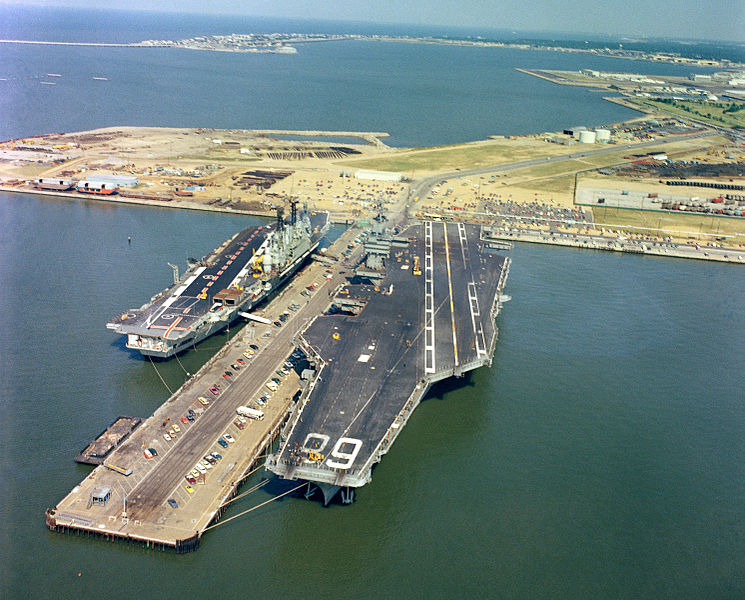
Ark Royal alongside USS Nimitz on a stopover at Norfolk, Virginia, during her 1978 WESTLANT final deployment
She entered HMNB Devonport, on 4 December 1978 to be decommissioned on 14 February 1979 following the new White paper recommandations. Her active career of just 24 year was not stellar giving the time she took in construction and overall cost but she brought to the table a capability no other British carrier ever had, both the Buccaneer and Phantom being mach 2, extremely capable models that could carry their full payload thans to the upgraded catapults. This capability was sorely lacking in the following decades, only partially adressed on the 2020s by the present Queen Elisabth class, which still are using a take-off ramp, and so restrains the capacity of its aircraft.
When the white Ensign lowered last, the Royal Navy was imposed the choice of scrapping its entire fixed-wing park, tha is until HMS Invincible entered service March 1980 and HMS Hermesconversion to also operate the Sea Harrier by mid-1981.
On 29 March 1980 the British MOD announced she would be sold for scrap, not preserved as many wished for. She left Devonport on 22 September 1980 under tow and proceeded to Cairnryan (near Stranraer) in Scotland on 28 September. Eagle was already there, completing her scrapping. It took until 1983 during which many former crew went to pay their last respects to the ship. Many souvenirs and memorials survived still, and anchor (at the FAA/RNAS museum Yeovilton) and Armada Way, Plymouth, among others.

Late photo in 1977, the geograph.uk
From her commissioning the prestigiously named ships spent as much time in refit and fixes or modernisation as in active service which only spanned 12 years. Towards the end, it took a lot of effort to keep her serviceable in between still, and these reports did not served her cause. Ark Royal was poorly preserved during construction in 1942-1955 for a start and her machinery was already obsolete at completion, all her old DC electrics with few AC systems trigerring a never ending story of electrical mishaps. Eagle was at least more reliable, better-built and her active life was longer (she also was saw action at Suez). Ark Royal nevertheless brought so many innovations, its sparked discussions about preserving her as museum ship, with private fundsraise, but itwwas never endorsed not supported by the MOD. The Fleet Air Arm Museum later used these founds to reproduce her island and flight deck, now on display in its central hall as its centerpiece exhibition.
Ironically the far less capable, emergency 1942 program light fleet carrier HMS Hermes remained in service much, much longer, albeit by being an helicopter commando carrier in 1971 and V/STOL carrier. The Invincible-class carrier were perhaps more satisfying for the MoD in terms of cost-effectiveness, and they served longer than Eagle or Ark Royal, but with their low payload Sea Harrier and helicopters, they never replaced the two fleet carriers. The two new Queen Elizabeth-class carriers commissioned in 2017 and 2019 were also V/STOL capable, despite their huge size, agains under costs cutting measure, instead of conventional CATOBAR. The Royal Navy still needs such carriers. Future will tell if the French PA-NG will be used as a base for a European-funded program with at least two built. The cost of converting the QE class into an electromagnetic-catapult version is still on the table.
Read More/Src
Books
Beaver, Paul (1979). Ark Royal, A pictorial history of the Royal Navy’s last conventional aircraft carrier. Cambridge
Bebbington, Dene (April 2017). “Ark Royal”. Ships Monthly. pp. 56–59.
Blackman, Raymond (1973). Ships of the Royal Navy. London, England: Macdonald and Jane’s.
Chesneau, Roger (1984). Aircraft Carriers of the World, 1914 to the Present: An Illustrated Encyclopedia. Annapolis, MD: Naval Institute Press.
Gardiner, Robert (1983). Conway’s All the World’s Fighting Ships 1947–1982. London, England: Conway Maritime Press.
Hobbs, David (October 2007). “HMAS Melbourne (II) – 25 years on”. The Navy. Vol. 69, no. 4. Sydney, Australia. pp. 5–9.
Hobbs, David (2013). British Aircraft Carriers: Design, Development and Service Histories. Barnsley, UK: Seaforth Publishing.
Links
hmsarkroyalassociation.org
maritimequest.com/
archive.ph/
web.archive.org/ sjgl.co.uk/ark-royal/
archive.org aircraftcarriers book
books.google.fr/ on pop mech
rmg.co.uk/ plans accessibles at Greenwhich
en.wikipedia.org/ HMS_Ark_Royal_(R09)
web.archive.org navypedia.org/
seaforces.org/
commons.wikimedia.org HMS_Ark_Royal_(R09)
reddit.com/ cutaway_of_the_audacious_class_fleet/
Videos
Instructional film of the 1970s
Model Kits

HMS Ark Royal R09, Eiriksson 1:600 001
Royal Navy Aircraft Carrier HMS Ark Royal IV 1970-78 Atlantic Models 1:700 44134
Sea Way Model Series British Aircraft Carrier Ark Royal Limited Edition Fujimi 1:700 (SWM-SP)
British Aircraft Carrier Ark Royal Fujimi 1:700

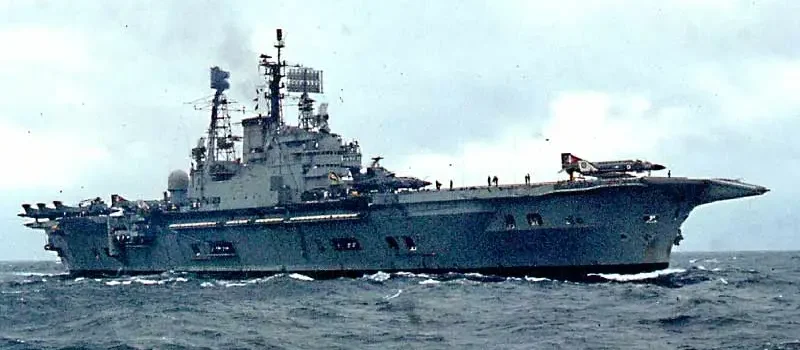
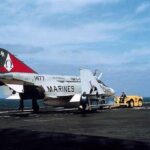
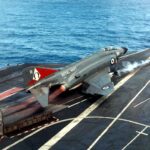
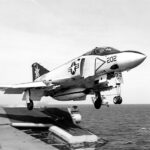

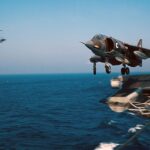
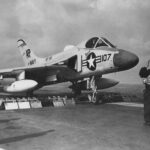
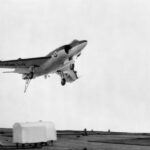

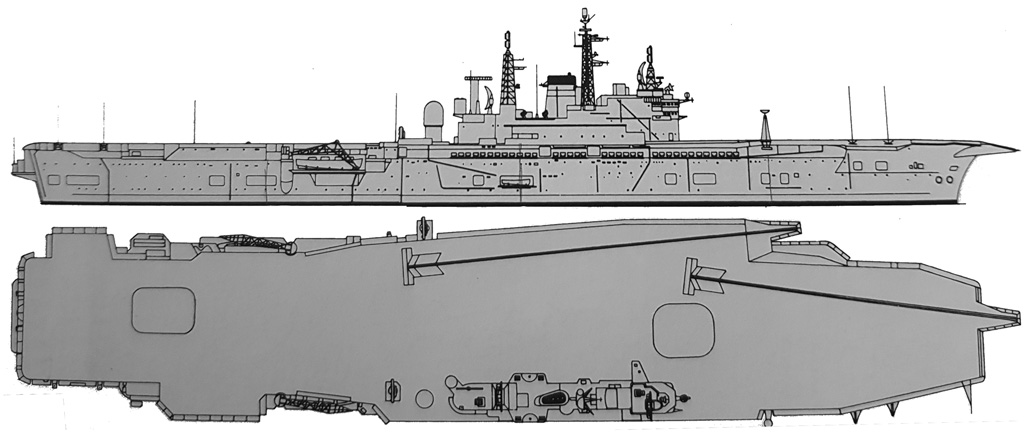
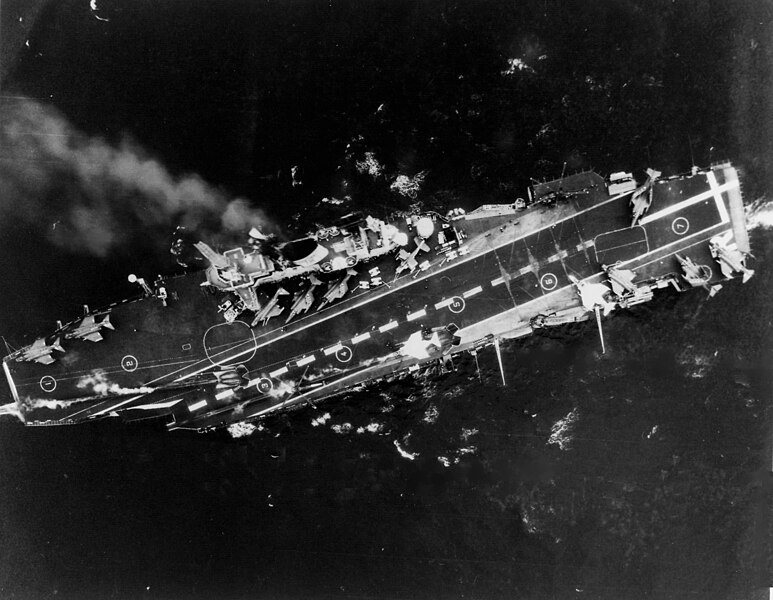

 Latest Facebook Entry -
Latest Facebook Entry -  X(Tweeter) Naval Encyclopedia's deck archive
X(Tweeter) Naval Encyclopedia's deck archive Instagram (@navalencyc)
Instagram (@navalencyc)





 French Navy
French Navy Royal Navy
Royal Navy Russian Navy
Russian Navy Armada Espanola
Armada Espanola Austrian Navy
Austrian Navy K.u.K. Kriegsmarine
K.u.K. Kriegsmarine Dansk Marine
Dansk Marine Nautiko Hellenon
Nautiko Hellenon Koninklije Marine 1870
Koninklije Marine 1870 Marinha do Brasil
Marinha do Brasil Osmanlı Donanması
Osmanlı Donanması Marina Do Peru
Marina Do Peru Marinha do Portugal
Marinha do Portugal Regia Marina 1870
Regia Marina 1870 Nihhon Kaigun 1870
Nihhon Kaigun 1870 Preußische Marine 1870
Preußische Marine 1870 Russkiy Flot 1870
Russkiy Flot 1870 Svenska marinen
Svenska marinen Søværnet
Søværnet Union Navy
Union Navy Confederate Navy
Confederate Navy Armada de Argentina
Armada de Argentina Imperial Chinese Navy
Imperial Chinese Navy Marinha do Portugal
Marinha do Portugal Mexico
Mexico Kaiserliche Marine
Kaiserliche Marine 1898 US Navy
1898 US Navy Sovietskiy Flot
Sovietskiy Flot Royal Canadian Navy
Royal Canadian Navy Royal Australian Navy
Royal Australian Navy RNZN Fleet
RNZN Fleet Chinese Navy 1937
Chinese Navy 1937 Kriegsmarine
Kriegsmarine Chilean Navy
Chilean Navy Danish Navy
Danish Navy Finnish Navy
Finnish Navy Hellenic Navy
Hellenic Navy Polish Navy
Polish Navy Romanian Navy
Romanian Navy Turkish Navy
Turkish Navy Royal Yugoslav Navy
Royal Yugoslav Navy Royal Thai Navy
Royal Thai Navy Minor Navies
Minor Navies Albania
Albania Austria
Austria Belgium
Belgium Columbia
Columbia Costa Rica
Costa Rica Cuba
Cuba Czechoslovakia
Czechoslovakia Dominican Republic
Dominican Republic Haiti
Haiti Hungary
Hungary Honduras
Honduras Estonia
Estonia Iceland
Iceland Eire
Eire Equador
Equador Iran
Iran Iraq
Iraq Latvia
Latvia Liberia
Liberia Lithuania
Lithuania Mandchukuo
Mandchukuo Morocco
Morocco Nicaragua
Nicaragua Persia
Persia San Salvador
San Salvador Sarawak
Sarawak Uruguay
Uruguay Venezuela
Venezuela Zanzibar
Zanzibar Warsaw Pact Navies
Warsaw Pact Navies Bulgaria
Bulgaria Hungary
Hungary

 Bundesmarine
Bundesmarine Dutch Navy
Dutch Navy Hellenic Navy
Hellenic Navy Marina Militare
Marina Militare Yugoslav Navy
Yugoslav Navy Chinese Navy
Chinese Navy Indian Navy
Indian Navy Indonesian Navy
Indonesian Navy JMSDF
JMSDF North Korean Navy
North Korean Navy Pakistani Navy
Pakistani Navy Philippines Navy
Philippines Navy ROKN
ROKN Rep. of Singapore Navy
Rep. of Singapore Navy Taiwanese Navy
Taiwanese Navy IDF Navy
IDF Navy Saudi Navy
Saudi Navy Royal New Zealand Navy
Royal New Zealand Navy Egyptian Navy
Egyptian Navy South African Navy
South African Navy






























 Ukrainian Navy
Ukrainian Navy dbodesign
dbodesign